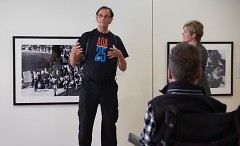Tom Olin returns to Grand Rapids after over 30 years of documenting the disability rights movement. "ACCESS IS A CIVIL RIGHT: The Photography of Tom Olin" is an exhibition at Calvin’s (106) Gallery and Studio on South Division Avenue. For the first time in a gallery setting, a large collection of Olin’s photographs are on display as part of DisArt, a 16-day multi-venue interdisciplinary arts festival.
While he used to hide it from his peers, Olin talks openly now about his dyslexia, a learning disability that impairs reading. After graduating high school Olin was drafted for the Vietnam War. He went to Canada initially but then came home to turn himself in as a conscientious objector.
Olin was consequently court-ordered to work at Mary Free Bed in Grand Rapids. As an orderly there, he cared for people with disabilities. Olin was often the only person around that patients could really talk to.
"They’ve been brought up to think maybe it’s better off dead than being disabled like this,” Olin recalls. “It was high drama. There was something there that sparked me and I knew that it was wrong for them to think they couldn’t do anything.”
These interactions eventually inspired his mission as a photographer and human rights activist.
While documenting the events that lead to the passage of Americans with Disabilities Act, Olin witnessed people realizing it was worth it to take action, that it was a civil right to have access. His photographs show protesters handcuffing themselves to a bus steering wheel or parking their wheelchairs in front of a running bus.
“It was hard to participate in society because you couldn’t go through doors. You couldn’t go to your friend's house because you couldn't get up their steps. Couldn’t even go to the bathroom. There was just all this inaccessibility,” Olin explains. “I knew that things could change and I ran into people who felt the same. Then people said it should be a law. It was a good fight. All kinds of people with disabilities gathered to do this.”
In addition to documenting the events of the disability rights movement, Olin’s lens captures the power of people normally viewed as weak.
“In the history of documentary photography, that’s not always the case,” Curator Lisa VanArragon notes during the gallery talk she shared with Olin. “Historically the documentarian is this voice of authority looking at the subjects and controlling the voice.”
She observes that Olin deliberately makes himself lower as he takes the pictures, altering his body to achieve a sense of power for his subject.
In order to make the exhibition accessible to people in wheelchairs, VanArragon hung the show at 45” from the floor. This is considerably lower than the gallery norm of 57,” based on the average eye level.
“It just seems so powerful to me to be in here and see them at this level,” Petra Kuppers, artistic director of Olimpias Disability Arts Collective commented on her experience viewing the exhibition of photographs while seated in her scooter. “It disrupts how images are shown at the gallery. You don’t just have the odd one down, you just have the whole thing at this different level. It makes you think about who we are that is watching and how there are different ways of watching. So to me the way you have arranged this in the gallery is itself a political act.”
After an opening Friday, April 10 and a gallery talk the following morning, Olin took off to continue his journey with the American Disability Association Legacy Tour Bus. Celebrating the 25th anniversary of the passage of the Americans with Disabilities Act, the bus is a civil rights memento and traveling exhibition making stops through 18 states to spread awareness.
Olin will return to Grand Rapids on April 24 with the ADA bus for last two days of the DisArt festival. He will give an artist presentation on his life and photography from 3:30 - 4:30 Saturday, April 25 at the DisArt HUB.
The Rapidian, a program of the 501(c)3 nonprofit Community Media Center, relies on the community’s support to help cover the cost of training reporters and publishing content.
We need your help.
If each of our readers and content creators who values this community platform help support its creation and maintenance, The Rapidian can continue to educate and facilitate a conversation around issues for years to come.
Please support The Rapidian and make a contribution today.


